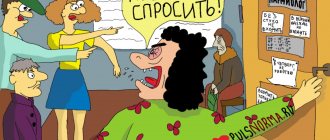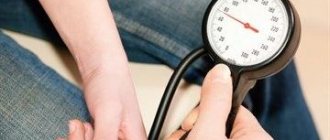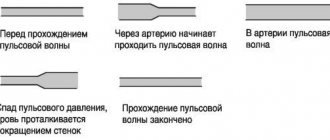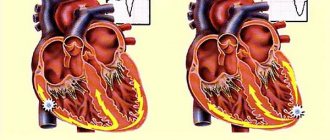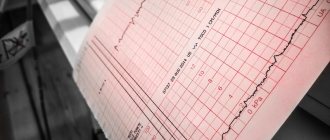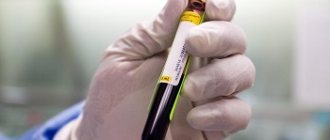This is the second article in a series about a healthy heart, author - Ksenia Benimetskaya, cardiologist, nutritionist, Ph.D. This time we’ll tell you how different types of activity affect the heart, how much and how to train so as not to overdo it.
Regular moderate physical activity maintains and improves heart health. This is exactly the same as in the #sekta courses
When the heart rate is generally elevated
It is worth remembering that there are categories of people whose heart rate is elevated, regardless of physical activity. “Most often, an increased heart rate occurs in obese people, as well as in people with little exercise who lead a sedentary lifestyle. Also, in young women we observe a slightly higher pulse than in men,” says Tatyana Shalygina.
The cardiologist notes that a heart rate from 60 to 90 is considered normal (previously this parameter was lower, a pulse of 60-80 was considered normal). This is provided that the person does not have any reliably confirmed cardiovascular diseases.
“With age, the requirements for pulse increase, especially if there are diseases of the heart and blood vessels, here we already achieve lower pulse values, including due to medications. But this is mainly in older patients with chronic cardiovascular diseases,” says Tatyana Shalygina.
Heart rate often depends on the autonomic nervous system, notes the cardiologist. First of all, the sympathetic nervous system is responsible for it. “In stressful situations and fatigue, there is an increase in heart rate precisely due to the sympathetic nervous system,” says Tatyana Shalygina.
The pulse can also increase against the background of ARVI as a reaction of intoxication, says the cardiologist. Moreover, this is possible for any virus. “The pulse can increase significantly, sometimes even up to 100-105 beats per minute,” says Tatyana Shalygina.
Those who, during exercise, feel not only palpitations, but also “fluttering” of the chest, should be especially careful. If they occur during physical activity, you should consult a doctor, warns the cardiologist.
A quieter pulse means you live longer. What should it be like normally? More details
What are the benefits of physical activity for the heart?
Physical activity maintains and improves health: has a positive effect on cognitive function, sleep, reduces the risk of depression and anxiety, helps maintain a normal weight and improves quality of life. And, most importantly, it improves heart function and prolongs life: as we wrote in the article “How Diet Impacts Heart Health,” cardiovascular disease (CVD) is one of the leading causes of death in the world.
How exactly movement helps the cardiovascular system:
- Prevents the development of atherosclerosis: by reducing body weight, blood pressure and cholesterol levels in the blood are normalized, insulin sensitivity is improved and the risk of developing type 2 diabetes is reduced.
- Prevents thrombosis.
- Improves the function of the endothelium lining blood vessels - the synthesis of nitric oxide and its bioavailability increases, the balance of oxidants and antioxidants in the vascular wall improves. Nitric oxide, an important molecule for the cardiovascular system, is responsible for the tone of the vascular wall, prevents platelet activation, and prevents leukocytes from sticking to the inner surface of blood vessels.
- It has anti-inflammatory, anti-ischemic and antiarrhythmic effects.
At the cellular level, regular exercise helps optimize energy use and increases resistance to oxidative stress.
It is thanks to these effects that those who move enough are less likely to suffer from heart attacks and strokes, arterial hypertension, less likely to die from cardiovascular diseases, live longer and have a higher quality of life.
Unfortunately, only 19% of women and 26% of men move enough. A sedentary lifestyle is widespread: one in four people in the world exercise less than they should, and this figure is growing.
Heartbeat in sports
An increase in heart rate during physical activity is generally considered normal, says the cardiologist. “The heart rate reasonably increases when we move and especially when there is active physical activity,” says Tatyana Shalygina.
To prevent problems, you should calculate in advance the optimal values for increased heart rate for physical training and carefully monitor it. “There are certain formulas by which the maximum and submaximal values of heart rate are calculated for a particular patient in accordance with age or gender, as well as weight. These are the parameters that are recommended to be achieved during training,” says Tatyana Shalygina.
There are many such formulas, the cardiologist emphasizes. You can calculate the optimal heart rate for exercise yourself. So, the simplest formula for submaximal values is 200 minus age, for maximum values - 220 minus age. “The only thing is that during exercise we do not recommend reaching the maximum; it is worth working up to 75% of the maximum heart rate,” says the cardiologist.
Therefore, during training, you should constantly monitor your heart rate values and react in time if something goes wrong.
What should a child's normal heart rate be during sleep? More details
Such different hypertrophies
The manifestations of a healthy sports heart and a pathological one are similar, but healthy cardiac hyperfunction is intermittent, characterized by a decrease during the period outside training and competition, while pathological hyperfunction is constant and becomes irreversible over time. The pathological heart is always at work because it must always overcome its hidden weakness. All this is referred to as a violation of the heart’s adaptation to stress - maladaptation, which can lead to sudden death.
The athlete does not feel the transition from a physiological sports heart to a pathological one, he simply becomes less efficient, gets tired easily and hardly recovers during rest, and attacks of dizziness are possible during training. During the examination, thickening of the heart muscle is revealed with insufficient relaxation in the diastole phase, this already indicates a disease - initial asymptomatic cardiomyopathy.
Not only the contractile function suffers, but also the formation of electrical potential for the implementation of contractions - rhythm is disrupted. Heart rhythm disturbances are manifested by untimely beats, irregular pulses, or simply loss of consciousness. When you rest from training, rhythm disturbances disappear, but changes in the heart muscle remain. Gradually, the heart muscle is replaced by scars, turning the ventricles of the heart into weakly contractible scar sacs, which “drive” blood with great difficulty, and heart failure progresses.
Myocardial hypertrophy, as a heart disease, and pathological athlete's heart have similarities, but in heart disease, hypertrophy is needed to compensate for an anatomical or functional defect, for example, valvular disease. With an athletic heart, hypertrophy is necessary for the implementation of muscle efforts, that is, it does not have an underlying defect. However, with any pathological hypertrophy, cellular metabolism is first disrupted, then the structure of the myocardium changes with the formation of scars, and finally, cardiac function suffers.
How to correct the situation?
“If, against the background of physical activity, you feel unwell or have a rapid heartbeat, you should stop exercising. But not sharply, but slowly. Be sure to endure a recovery period when the pulse returns to normal. For example, reduce the load a little if this happened on the treadmill, reduce the speed if you can’t tolerate it well and your heart rate has increased significantly,” says Tatyana Shalygina. Yes, the pulse has the right to rise against the background of the load, it will be scary if it does not react to the load and does not increase. But an overly active heartbeat should also be a signal that something is wrong.
From the point of view of an increase in heart rate and assessing whether this is normal, a person’s fitness also matters. If a person is an athlete, his heart rate will initially be lower, and his pulse will rise more slowly during exercise.
Today, fitness clubs ask for a cardiologist's opinion or a certificate of admission to physical education and sports. You can also get tested at a specialized sports dispensary. This will eliminate contraindications to exercise, the cardiologist notes. “We sometimes ask to undergo a stress test in order to record a cardiogram during exercise and make sure that the person tolerates physical activity well,” says Tatyana Shalygina.
This will allow you to structure your workouts more competently, to know exactly the heart rate values, so that you can correctly monitor it and reduce it in time during the training process.
My heart trembled. When arrhythmia becomes deadly Read more
What is Cardiac drift or the reasons for increased heart rate during uniform exercise?
Home > news » What is Cardiac drift or the reasons for the increase in heart rate under uniform load
Imagine - you went for an easy recovery run. You plan to run for about 40 minutes, there and back. The weather is hot and dry, summer is over the yard. During the second part of the workout, you look at your heart rate monitor and see that your heart rate is 150 beats per minute.
This is a little higher than your normal recovery workout heart rate, but you're running easy, so you decide your heart rate monitor is just a little off. You continue at the same easy pace and at the end of the run you see that your heart rate has jumped to a strange 162 beats per minute. You know something is wrong because you haven't increased your pace, but your heart rate has increased by 12 beats in the last 20 minutes.
What happened to you has a name - in English sports literature this phenomenon is called “cardiac drift” . In Russian sports medicine, we have not found a suitable term, but the cardiological community agrees that such a phenomenon can be called “cardiac shift” .
Why is this happening?
During aerobic exercise (such as light running), your body requires oxygen, which is supplied to the muscles through the blood. Blood in turn consists of blood cells and plasma, and plasma is 90% water.
When you exercise on a hot day, you sweat more than usual. The liquid evaporates from your skin, thereby cooling your body. But for us, it is of great importance where this liquid comes from, because it is mainly liquid from blood plasma that is used for cooling purposes.
Therefore, with active sweating, unbalanced by water consumption, our blood thickens and becomes like syrup.
Let's go back to your workout - you are running at the same pace and your muscles' need for oxygen is not decreasing. But thick blood when dehydrated is less able to cope with this task, so your heart has to pump blood more actively.
When you start an easy jog, your heart rate is around 120 beats. If the weather is not too hot or too cold, your heart rate will be more or less stable throughout the workout. On a hot day, your cardiovascular system is affected by the mechanism described above - and your heart rate increases.
This slow increase in heart rate during cyclic sports is called “cardiac drift” or “cardiac drift”.
The statement about the connection between dehydration and increased heart rate is not groundless. For example, a study involving cyclists showed that the heart rate of athletes who did not drink liquid during a 2-hour workout increased by an average of 10%, while the heart rate of athletes who drank regularly increased by only 5%.
How to avoid this?
The logical question now would be “what should I do with this information now?”
First of all, you should know that blood thickening is a rather dangerous thing. With him:
- the load on the heart increases, as it has to contract more often to provide the organs with oxygen
- blood supply to tissues and organs deteriorates, since thick blood has worse permeability, especially in small vessels and capillaries.
Regular thickening of the blood leads to even more serious consequences, causing stagnation, leading to the development of varicose veins and the formation of blood clots
To avoid such effects:
- Firstly, we recommend using a heart rate monitor in your workouts. It will help you avoid going into unnecessary heart rate zones, train more efficiently, and also not get too close to your maximum heart rate.
In addition, a heart rate monitor often allows you to notice a problem - for example, overtraining or illness, and in the case described above - a lack of fluid.
- secondly, don't forget to drink! Don't believe the popular belief among some unqualified trainers that training without drinking is more effective. Try to keep yourself hydrated during long workouts and/or in hot weather.
By the way, the now widespread advice to drink more clean water is actually a very simple and at the same time very useful action in relation to your body.
Remember also that with sweat we lose not only fluid, but also salts, so during heavy training use not just water, but isotonics or electrolytes.
The article uses materials from the page https://www.active.com/running/articles/what-is-cardiac-drift-and-how-it-affects-runners?page=2.
Training rules
To prevent training from negatively affecting your heart condition, you should follow simple rules. “If you come to a fitness club for the first time, it is reasonable to contact a trainer to choose an adequate physical activity for yourself, taking into account your weight, age, and the presence of chronic diseases. You should also not overdo it in the club, especially during the first lesson. After all, you should understand that this is already stressful for you, and before there was no proper physical activity,” says Tatyana Shalygina.
It is worth strictly remembering the stages and frequency of training. “First of all, the key to the success of training is its regularity, which means 2-3 times a week. In addition, they must be at least an hour in total when you visit a fitness club. This is true even for walking outside, which we often recommend to patients with cardiovascular disorders. We recommend walking for at least an hour, preferably 2 hours. And we recommend taking 6-10 thousand steps a day,” says the cardiologist.
In addition, Tatyana Shalygina notes, the stages of training are also important for proper heart function. The first stage is preparation for the load. It takes approximately 10-15 minutes from the workout if we take the workout for an hour. The main stage should be about 30 minutes, when the main load on the body occurs. And, of course, a recovery period is required, when a person gradually reduces the load, including restoring the heartbeat.
“If at any stage, especially in the first days of attending training, any complaints arise in the form of severe shortness of breath, increased palpitations that the patient feels, a feeling of interruptions in the heart’s function, you should slowly stop training and then seek advice from a cardiologist or a therapist,” says Tatyana Shalygina.
The “correct” heart of an athlete
The heart of an athlete is referred to as “athletic.” There is a distinction between a heart adapted to high loads, which adequately ensures the functioning of the body, and a pathological sports heart formed by excessive loads for the myocardium. There is an increase in the thickness of the wall - the mass of the myocardium, the cavities of the ventricles and atria increase, but this happens in different ways.
The physiological or “correct” athletic heart itself is better nourished due to the expansion of its own coronary capillary network and increased formation of new vessels. The large thickness of the walls allows them to effectively and intensely contract and relax, due to the high elasticity and significant energy reserves in the cardiomyocyte - the myocardial cell. The cavities of the atria and ventricles enlarge to receive and subsequently release a larger volume of blood during athletic activity.
Different sports change the configuration of the heart in their own way, it all depends on the pace at which the athlete moves. All athletes have increased thickness of the ventricular myocardium, but in all dynamic and “running” sports, including cycling and swimming, the volume of the internal cavity of the ventricles increases. The ventricles are uniformly large - thick walls correspond to a large internal volume, which is necessary for increased and enhanced blood release.
During “standing” sports, for example, wrestling and weightlifting, blood pressure increases excessively, and with a normal size of the ventricular cavity, its wall is thickened, which is why visually the ventricle looks unevenly enlarged: the wall is thick, and the internal cavity is small.
In rowing sports there is an alternation of dynamic and static loads, therefore the changes in the myocardium are average between the two main options. Racial characteristics also affect the configuration of the correct athletic heart; the maximum severity of the configuration is observed in athletes of the Negroid race, so they are the fastest and most resilient.
At rest, the athlete’s heart works in an economical mode with a small number of contractions - 40-60 per minute, its need for oxygen decreases, the relaxation phase (diastole) exceeds the contraction phase (systole), the blood flow speed drops - blood pressure is reduced. This is a kind of suspended animation of the heart muscle, the purpose of which is complete rest, so that at the decisive moment you can devote yourself entirely to work of unprecedented intensity.

